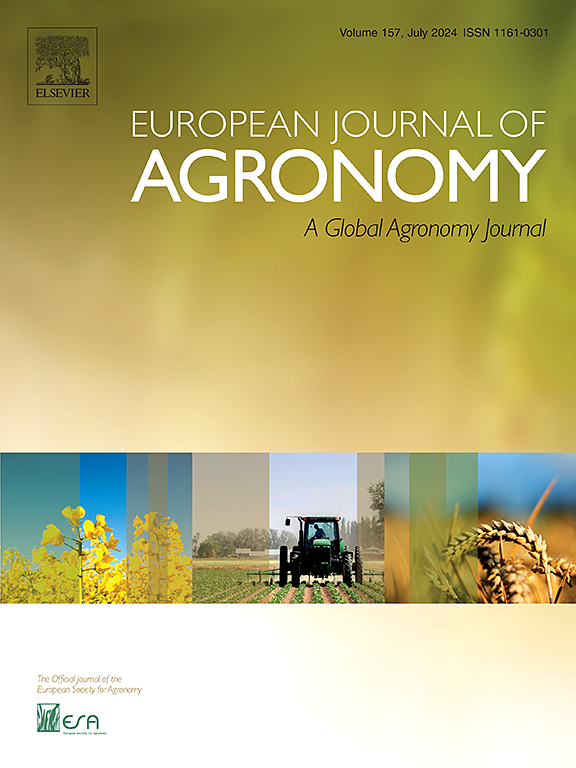早熟棉产量随播期和生长季节的变化与资源利用的差异有关
IF 5.5
1区 农林科学
Q1 AGRONOMY
引用次数: 0
摘要
在中国黄河流域的棉花种植区,棉花播种日期通常为 5 月初至 6 月初。早熟棉花的产量随播种日期和生长季节的不同而变化很大。我们假设这些产量变化主要是由于资源利用效率的差异造成的。从 2021 年到 2023 年,我们对早熟棉花品种 "中棉所 134 "进行了为期 3 年的田间试验,以监测不同播种期的光热资源。结果表明,2023 年 5 月 6 日播种的棉花产量最高(3455.26 千克/公顷-1),而 2021 年 4 月 12 日播种的棉花产量最低(1832.41 千克/公顷-1),三年中最高产量分别比最低产量高出 28.0%、42.8% 和 46.97%。LAI 与产量呈负相关,而真叶数和生物量呈正相关。PLS 分析表明,光能利用率(Eu)通过生物量和累积温度利用效率(TPE)影响产量,而热量资源利用率(HUE)和 TPE 直接影响产量(r = 0.776,r = -0.971,P <0.001)。播种日期对真叶片数、叶片成熟度和产量有明显影响,气候因素间接影响产量。生物量、HUE 和 TPE 直接影响产量。2022 在晚播时生物量和 LAI 峰值较高,而在早播时产量较高。晚播导致 2021 年和 2023 年产量较高。这项研究强调了播种期和生长季在通过资源利用率调节棉花产量方面的作用,为优化棉花生产管理提供了依据。本文章由计算机程序翻译,如有差异,请以英文原文为准。
Yield variation in early-maturing cotton in response to sowing dates and growing seasons is associated with differential resource utilization
In the cotton-growing region of the Yellow River Basin in China, cotton sowing dates typically range from early May to early June. The yield of early-maturing cotton varies significantly with sowing dates and growing seasons. We hypothesize that these yield variations are primarily due to differences in resource utilization efficiency. A 3-year field experiment was conducted from 2021 to 2023 with early maturing cotton variety ‘Chinese Cotton Research Institute 134’ to monitor light and heat resources at different sowing dates. Results showed that cotton sown on May 6, 2023, achieved the highest yield (3455.26 kg ha−1), while April 12, 2021, had the lowest yield (1832.41 kg ha−1), with the highest yield exceeding the lowest by 28.0 %, 42.8 %, and 46.97 % over three years. LAI negatively correlated with yield, while true leaf number and biomass were positively correlated. PLS analysis showed that light energy utilization (Eu) influences yield through biomass and accumulated temperature utilization efficiency (TPE), while heat resource utilization (HUE) and TPE directly influence yield (r = 0.776, r = −0.971, P < 0.001). Sowing date significantly affected true leaf number, LAI, and yield, with climate factors indirectly impacting yield. Biomass, HUE, and TPE directly influenced yield. 2022 showed higher biomass and LAI peaks in the late sowing, and higher yield in the early sowing. Late sowing resulted in higher yield in 2021 and 2023. This study highlights the role of sowing date and growing season in regulating cotton yield through resource utilization, providing a basis for optimizing cotton production management.
求助全文
通过发布文献求助,成功后即可免费获取论文全文。
去求助
来源期刊

European Journal of Agronomy
农林科学-农艺学
CiteScore
8.30
自引率
7.70%
发文量
187
审稿时长
4.5 months
期刊介绍:
The European Journal of Agronomy, the official journal of the European Society for Agronomy, publishes original research papers reporting experimental and theoretical contributions to field-based agronomy and crop science. The journal will consider research at the field level for agricultural, horticultural and tree crops, that uses comprehensive and explanatory approaches. The EJA covers the following topics:
crop physiology
crop production and management including irrigation, fertilization and soil management
agroclimatology and modelling
plant-soil relationships
crop quality and post-harvest physiology
farming and cropping systems
agroecosystems and the environment
crop-weed interactions and management
organic farming
horticultural crops
papers from the European Society for Agronomy bi-annual meetings
In determining the suitability of submitted articles for publication, particular scrutiny is placed on the degree of novelty and significance of the research and the extent to which it adds to existing knowledge in agronomy.
 求助内容:
求助内容: 应助结果提醒方式:
应助结果提醒方式:


